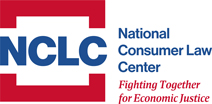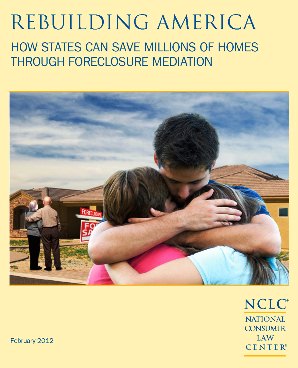How States Can Save Millions of Homes Through Foreclosure Mediation
The evidence is in: Foreclosure mediation programs are a proven, inexpensive tool to help keep paying borrowers in their homes while saving communities and investors billions of dollars.
Download the Full Report (PDF)
Dowload the Executive Summary (PDF)
Download Tables (PDF)
Download the Press release (PDF)
Web only:
Summaries of supervised state foreclosure mediation programs
Summaries of unsupervised state foreclosure mediation programs
Previous foreclosure mediation reports and other resources
Related NCLC Foreclosures & Mortgages materials
In 2012, the U.S. is reaching the mid-point of a devastating foreclosure crisis, expected to result in an additional 10 million homes being lost (nearly 3 million homeowners have already been displaced through foreclosures). Yet there is an inexpensive fix to the broken housing crisis.
The evidence is in: States that adopt strong foreclosure mediation programs can keep paying borrowers in their homes over the long term while saving billions of dollars for taxpayers and investors. Such programs are an inexpensive tool in the toolkit to help rebuild America. State policymakers who ignore this option are needlessly exposing families and communities to severe, long-term hardships that can be avoided.
This nationwide report reviews existing programs in 19 states and makes recommendations for best practices for all states to adopt, using foreclosure mediation data from the last three years to draw its conclusions. The report includes examples of programs that are more successful and those that are less so; state references per section; tables; and a history, including statistics, of documented mortgage servicer problems and the Home Affordable Modification Program (HAMP).
Highlights and key recommendations from the report include:
- Foreclosure mediation programs and conferences provide substantial community benefits at little or no cost. Mediation fees average from none to less than $1,000, typically paid by the homeowner and/or the mortgage lender. In comparison, investors lost an average $145,000 per home foreclosure in 2008, and foreclosures just in California have resulted in nearly $500 billion in aggregate direct and indirect costs.
- Effective mediation programs do not prolong foreclosures. Most mediation programs work within the time frames for existing state laws. In Philadelphia, for example, the typical foreclosure case spent 53 days in a foreclosure conference while the average time frame to complete an uncontested foreclosure was 10 months.
- Foreclosure mediation programs connect borrowers with housing counselors. Borrowers who receive housing counseling are much more likely to avoid foreclosure, and obtain affordable as well as sustainable loan modifications. According to a recent study, 63% of borrowers who obtained modifications with counseling sustained the modifications, while only 8%of borrowers who obtained modifications without counseling sustained them.
- Not all foreclosure mediation programs are equal; all states should adopt foreclosure mediation programs with enforceable standards and robust outreach as permanent features of state foreclosure laws as quickly as possible. Florida’s mediation program lacked enforceable standards, did not compel servicers to negotiate in good faith, and had an ineffective outreach component, so many homeowners were unaware of it. The state recently suspended the program due to lack of participation. By contrast, New York and Connecticut programs are reaping more success.
- Mediation programs must ensure that the FHFA servicing guidelines do not lead to unnecessary foreclosures. Fannie Mae and Freddie Mac have implemented new servicing guidelines that will encourage servicers to speed up foreclosures to comply with a directive from the U.S. Federal Housing Finance Agency. Rules for mediation programs must be tightened to ensure that stays of all foreclosure actions remain in place pending a full loss mitigation review.
- Strong foreclosure mediation programs can work hand-in-hand with other tools to rebuild the nation’s broken mortgage market and should be used to maximize HAMP modifications. As documented in previous NCLC reports, servicers can make sustainable loan modifications yet many choose not to do so. The modified loans’ default rate over one year dropped from 56.2% in 2008 to 25.7% in 2010. HAMP loan modifications were the most sustainable of all with a 19.4% (2010) and 17.3% (2011) redefault rate after one year.
- Policymakers can use mediation programs to help preserve minority homeownership; gains made over the last decade are vanishing. Black and Latino homeowners face a doubly high foreclosure rate, even when adjusted for income. Many minority families were initially targeted for unaffordable subprime loans, and are denied loan modifications more often and steered into less affordable non-HAMP loan modifications more frequently than non-minority homeowners. Mediation programs provide needed oversight over practices that continue to disproportionately impact minorities.
- Borrowers in mediation must receive accurate information about an increasingly unaffordable rental market. Renters, especially those who are low-income, are more than twice as likely as homeowners to spend more than 50 percent of income for housing. Mediation programs should refer all homeowners to housing counselors to evaluate the costs of renting before giving up on saving a home.

